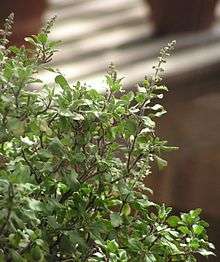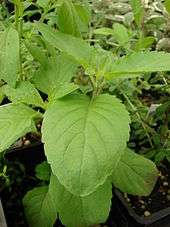Ocimum tenuiflorum
Ocimum tenuiflorum (synonym Ocimum sanctum), commonly known as holy basil or Tulsi, is an aromatic perennial plant in the family Lamiaceae. It is native to the Indian subcontinent and widespread as a cultivated plant throughout the Southeast Asian tropics.[2][3]
| Ocimum tenuiflorum | |
|---|---|
 | |
| Scientific classification | |
| Kingdom: | Plantae |
| Clade: | Tracheophytes |
| Clade: | Angiosperms |
| Clade: | Eudicots |
| Clade: | Asterids |
| Order: | Lamiales |
| Family: | Lamiaceae |
| Genus: | Ocimum |
| Species: | O. tenuiflorum |
| Binomial name | |
| Ocimum tenuiflorum L. | |
| Synonyms[1] | |
| |
Tulsi is cultivated for religious and traditional medicine purposes, and for its essential oil. It is widely used as a herbal tea, commonly used in Ayurveda, and has a place within the Vaishnava tradition of Hinduism, in which devotees perform worship involving holy basil plants or leaves.
The variety of Ocimum tenuiflorum used in Thai cuisine is referred to as Thai holy basil (Thai: กะเพรา kaphrao);[2] it is not the same as Thai basil, which is a variety of Ocimum basilicum.
Morphology


Holy basil is an erect, many-branched subshrub, 30–60 cm (12–24 in) tall with hairy stems. Leaves are green or purple; they are simple, petioled, with an ovate, up to 5 cm (2.0 in)-long blade, which usually has a slightly toothed margin; they are strongly scented and have a decussate phyllotaxy. The purplish flowers are placed in close whorls on elongated racemes.[3]
The three main morphotypes cultivated in India and Nepal are Ram tulsi (the most common type, with broad bright green leaves that are slightly sweet leaves), the less common purplish green-leaved (Krishna tulsi) and the common wild vana tulsi.[4]
Origin and distribution
DNA barcodes of various biogeographical isolates of tulsi from the Indian subcontinent are now available. In a large-scale phylogeographical study of this species conducted using chloroplast genome sequences, a group of researchers from Central University of Punjab, Bathinda, have found that this plant originates from North-Central India.[5][6]
Significance in Hinduism
Tulsi leaves are part in the worship of Vishnu and his avatars and some other deities, including Krishna and Rama, and other male Vaishnava deities, such as Hanuman and some brahmanas. Tulsi is a sacred plant for Hindus and is worshipped as the avatar of Lakshmi. Traditionally, tulsi is planted in the center of the central courtyard of Hindu houses or may be grown next to Hanuman temples.[7]
The ritual lighting of lamps each evening during Kartik includes the worship of the tulsi plant, which is held to be auspicious for the home.[8][9] Vaishnavas traditionally use Hindu prayer beads made from tulsi stems or roots, which are an important symbol of initiation. They have such a strong association with Vaishnavas, that followers of Vishnu are known as "those who bear the tulsi round the neck".[7]
Tulsi Vivah is a ceremonial festival performed anytime between Prabodhini Ekadashi (the 11th or 12th lunar day of the bright fortnight of the Hindu month of Kartik) and Kartik Poornima (the full moon of the month). The day varies regionally.[10][11]
Uses
Tulsi (Sanskrit:-Surasa) has been used in Ayurveda and Siddha practices for its supposed treatment of diseases.[12][13] For centuries, the dried leaves have been mixed with stored grains to repel insects.[14]
Chemical composition
Some of the phytochemical constituents of tulsi are oleanolic acid, ursolic acid, rosmarinic acid, eugenol, carvacrol, linalool, and β-caryophyllene (about 8%).[15]
Tulsi essential oil consists mostly of eugenol (~70%) β-elemene (~11.0%), β-caryophyllene (~8%), and germacrene (~2%), with the balance being made up of various trace compounds, mostly terpenes.[16]
Genome sequence
The genome of the tulsi plant has been sequenced and reported as a draft, estimated to be 612 mega bases, with results showing genes for biosynthesis of anthocyanins in Shyama Tulsi, ursolic acid and eugenol in Rama Tulsi.[17]
Gallery
 O. tenuiflorum
O. tenuiflorum Tulsi in a home garden
Tulsi in a home garden Tulsi leaf
Tulsi leaf Closeup of inflorescence
Closeup of inflorescence_Flower.jpeg) Flower of tulsi
Flower of tulsi Tulsi flowers
Tulsi flowers- An altar with tulsi plant for daily worship in a courtyard
_of_Tulasi_wood_with_108_beads_-_20040101-01.jpg) Prayer beads made from tulsi wood
Prayer beads made from tulsi wood
See also
References
- "The Plant List: A Working List of All Plant Species". Retrieved 13 January 2015.
- Staples, George; Michael S. Kristiansen (1999). Ethnic Culinary Herbs. University of Hawaii Press. p. 73. ISBN 978-0-8248-2094-7.
- Warrier, P K (1995). Indian Medicinal Plants. Orient Longman. p. 168. ISBN 978-0-86311-551-6.
- Kothari, S. K.; Bhattacharya, A. K.; Ramesh, S.; Garg, S. N.; Khanuja, S. P. S. (November–December 2005). "Volatile Constituents in Oil from Different Plant Parts of Methyl Eugenol-Rich Ocimum tenuiflorum L.f. (syn. O. sanctum L.) Grown in South India". Journal of Essential Oil Research. 17 (6): 656–658. doi:10.1080/10412905.2005.9699025.
- Bast, Felix; Pooja Rani; Devendra Meena (2014). "Chloroplast DNA Phylogeography of Holy Basil (Ocimum tenuiflorum) in Indian Subcontinent". The Scientific World Journal. 70 (3): 277–85. doi:10.1155/2014/847482. PMID 847482.
- Lang, E. K. (1977). "Asymptomatic space-occupying lesions of the kidney: A programmed sequential approach and its impact on quality and cost of health care". Southern Medical Journal. 70 (3): 277–85. doi:10.1097/00007611-197703000-00007. PMC 1504262. PMID 847482.
- Simoons, Frederick J. (1998). Plants of life, plants of death. Univ of Wisconsin Press. pp. 7–40. ISBN 978-0-299-15904-7.
- Flood, Gavin D. (2001). The Blackwell companion to Hinduism. Wiley-Blackwell. p. 331. ISBN 978-0-631-21535-6.
- Wilkins, W.J. (2003). Hindu Mythology. New Delhi: D.K. Printworld. p. 471. ISBN 978-81-246-0234-8.
- Underhill, M. M. (1991). The Hindu Religious Year. Asian Educational Services. pp. 129–131. ISBN 978-81-206-0523-7.
- Pawar, Shubhangi; Patil, D. A. (2008). Ethnobotany of Jalgaon District, Maharashtra. Daya Publishing House. p. 400. ISBN 978-81-7035-515-1.
- NIIR Board, National Institute of Industrial Research (India) (2004). Compendium of Medicinal Plants. 2004. National Institute of Industrial Research. p. 320. ISBN 978-81-86623-80-0.
- Lesley Braun; Marc Cohen (30 March 2015). Herbs and Natural Supplements, Volume 2: An Evidence-Based Guide. Elsevier Health Sciences. p. 996. ISBN 978-0-7295-8173-8.
- Biswas, N. P.; Biswas, A. K. (2005). "Evaluation of some leaf dusts as grain protectant against rice weevil Sitophilus oryzae (Linn.)". Environment and Ecology. 23 (3): 485–488.
- Sundaram, R. Shanmuga; Ramanathan, M; Rajesh, R; Satheesh, B; Saravanan, D (2012). "Lc-Ms Quantification of Rosmarinic Acid and Ursolic Acid in Theocimum Sanctumlinn. Leaf Extract (Holy Basil, Tulsi)". Journal of Liquid Chromatography & Related Technologies. 35 (5): 634. doi:10.1080/10826076.2011.606583.
- Padalia, Rajendra C.; Verma, Ram S. (2011). "Comparative volatile oil composition of four Ocimum species from northern India". Natural Product Research. 25 (6): 569–575. doi:10.1080/14786419.2010.482936. PMID 21409717.
- Upadhyay, Atul K.; Chacko, Anita R.; Gandhimathi, A.; Ghosh, Pritha; Harini, K.; Joseph, Agnel P.; Joshi, Adwait G.; Karpe, Snehal D.; Kaushik, Swati; Kuravadi, Nagesh; Lingu, Chandana S; Mahita, J.; Malarini, Ramya; Malhotra, Sony; Malini, Manoharan; Mathew, Oommen K.; Mutt, Eshita; Naika, Mahantesha; Nitish, Sathyanarayanan; Pasha, Shaik Naseer; Raghavender, Upadhyayula S.; Rajamani, Anantharamanan; Shilpa, S; Shingate, Prashant N.; Singh, Heikham Russiachand; Sukhwal, Anshul; Sunitha, Margaret S.; Sumathi, Manojkumar; Ramaswamy, S.; Gowda, Malali; Sowdhamini, Ramanathan (28 August 2015). "Genome sequencing of herb Tulsi (Ocimum tenuiflorum) unravels key genes behind its strong medicinal properties". BMC Plant Biology. 15 (1): 212. doi:10.1186/s12870-015-0562-x. PMC 4552454. PMID 26315624.
External links
![]()